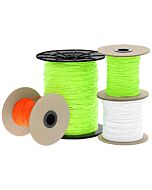Reel Reload Service
- We will machine strip the existing line from the selected reel on your order.
- We will machine reload the reel using your choice of any of our high-technology line.
- We use a line counter to measure the amount of line loaded, but also load a little more to account for inaccuracies.
- The final price is based on a small fee that depends on the size of the reel body, plus the type and amount of line.
- When you select the reel body, you will see our advice for the maximum QTY (length in feet) of line that will completely fill the spool, but without "overloading".
- If you wish any pre-existing line to be returned to you, there is small charge for a cardboard spool to collect the stripped line.
Custom manufactured for Dive Gear Express, both our DGX Hi-Viz and DGX Ultra-Viz™ lines are round braided polyester and are engineered high-tech products with exceptional strength, abrasion and UV resistance. The only difference is the DGX Ultra-Viz line includes a retroreflective nylon strand impregnated with tiny glass micro-beads (<100 microns) that makes the already vibrant line even brighter. Similar to the way SOLAS tape works, when light shines on the strand the light retroreflects toward the source of the light, thus further increasing visibility. The technical specification for the diameter of these lines is approximately 1.8 mm which does not fit nicely into the archaic 'twine' size code numbers that might be familiar to long time cave divers. Describing the diameter using size codes, the line falls between #21 and #24. Regardless, the 1.8 mm polyester line in water is stronger than #36 nylon and thinner than #24 nylon so you will be able to load a little extra on the reel.
The Divesoft Polyethersulfone (PES) line has been custom braided for diving applications. . This material is often compared to UHMWPE cordage, such as those from Spectra® or Dyneema®, though PES is slightly stronger than UHMWPE as well being heavier. Unlike UHMWPE, this material is negatively buoyant and holds knots well (its not 'slippery'), but isn't considered spliceable. This line has a little less stretch than nylon #24 but when wet Divesoft tests found a {10 ft | 3 m} length of their PES line to have about {2-4 in |50-100 mm} of stretch when simulating tension to mimic a tie-off. The prominent characteristic of the PES material is the exceptional tenacity; in water it is over five times stronger than polyester with very good abrasion resistance. In archaic twine sizing the 1.6 mm diameter falls between #18 (~ 1.5mm) and #21(~ 1.7mm); thinner but many times stronger than nylon #24, it also maintains it's shape better than nylon and you can load plenty of extra on the reel.
| Brand | DGX |
|---|---|
| SKU | DX-RELOAD |
| Weight | 2.000000 |
Customer Reviews
Characteristics of Line on Dive Reels and Finger Spools
Traditionally, the line on dive reels is a braided thermoplastic fiber made from polyamide (aka Nylon and PA) or more recently polyester terephthalate (aka Dacron and PET) ; each have their pros and cons. Both are strong, but nylon has significantly more elasticity while polyester has very little stretch. In water, nylon tends to become a little 'soggy' and swell slightly thus losing about 15% of its strength, while polyester retains 100% of its strength remaining 'crisp' and resilient when wet. Polyester has better resistance to abrasion and oil products, plus it is significantly more resistant to degrading from UV exposure. Polyester also noticeably better absorbs and retains the high-visibility color dyes (Orange or Chartreuse, Which is Better?). Many divers prefer polyester line claiming it deploys 'smoother' from the reel and is noticeably stronger; other divers still prefer nylon claiming its elasticity makes it easier to handle and 'tie off' in guideline applications. A few dive equipment manufacturers have been experimenting with high performance thermoplastics such as polyethersulfone (PES) and ultra-high-molecular-weight polyethylene (UHMWPE). These newer materials are many times the strength of polyester.
| Material Trade name |
Polyethersulfone Ultrason |
UHMWPE Dyneema |
Polyester Dacron |
Polyamide Nylon |
|---|---|---|---|---|
| Dry Tenacity (cN/dtex)
|
28 - 38
|
28 - 38
|
7 - 8
|
6 - 7
|
| Elongation at break (%)
|
28
|
3.5
|
10 - 16
|
16 - 27
|
| Specific gravity (g/cm
3)
|
1.37
|
0.98
|
1.38
|
1.15
|
| Melting point (°C)
|
227
|
149
|
260
|
220
|
| Abrasion resistance
|
excellent
|
very good
|
excellent
|
very good
|
| UV resistance
|
poor
|
very good
|
excellent
|
good
|
| Salt resistance
|
excellent
|
excellent
|
good
|
good
|
| Resistance to oil products
|
excellent
|
excellent
|
excellent
|
good
|
| Knot strength (%)
|
55 - 60
|
35 - 50
|
55 - 60
|
60 - 65
|
The size code numbers that describe the diameters of nylon guideline used in cave diving are from an archaic nomenclature for what is termed "twine" (braided string) and each # code describes an approximate thickness range in fractions of an inch. There does not appear to be an established standard (if you know of one, please tell us); size charts vary depending on the cordage manufacturers who each publish their own version for their products. There are four sizes normally seen on guideline reels: #36 and #24 are most common for nylon with #21 and #18 most common for polyester because it is stronger. The thinner the line the more length that can be fit on a given size reel or conversely the smaller the size of the reel for a given length. However, #18 is approaching the minimum diameter practical for manageable line handling in diving applications.








